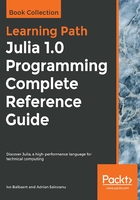
for loops
We already encountered the for loop when iterating over the element e of a collection coll (refer to the Strings, Ranges and Arrays sections in Chapter 2, Variables, Types, and Operations). This takes the following general form:
# code in Chapter 4\repetitions.jl for e in coll # body: process(e) executed for every element e in coll end
Here, coll can be a range, a string, an array, or any other iterable collection (for other uses, also refer to Chapter 5, Collection Types). The variable e is not known outside the for loop. When iterating over a numeric range, often = (equal to) is used instead of in:
for n = 1:10
print(n^3)
end
(This code can be a one-liner, but is spread over three lines for clarity.) The for loop is generally used when the number of repetitions is known.
You can also use ϵ instead of in or =.
If you need to know the index when iterating over the elements of an array, run the following code:
arr = [x^2 for x in 1:10] for i = 1:length(arr)
println("the $i-th element is $(arr[i])") end
A more elegant way to accomplish this uses the enumerate function, as follows:
for (ix, val) in enumerate(arr)
println("the $ix-th element is $val") end
Nested for loops are possible, as in this code snippet, for a multiplication table:
for n = 1:5
for m = 1:5
println("$n * $m = $(n * m)")
end
end
However, nested for loops can often be combined into a single outer loop, as follows:
for n = 1:5, m = 1:5
println("$n * $m = $(n * m)")
end